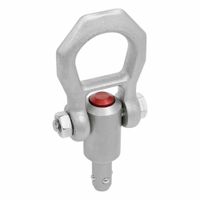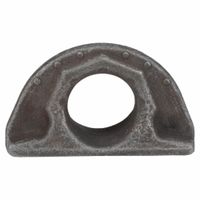Call +(254) 703 030 000 / 751 483 999 / 721 704 777
.....Read More
Frequently Asked Questions
What are the different types of hoist rings and their applications?
Hoist rings are lifting devices used to attach loads to lifting equipment. They come in various types, each suited for specific applications:
1. **Swivel Hoist Rings**: These can rotate 360 degrees and pivot 180 degrees, allowing for multi-directional lifting. They are ideal for applications where the load's orientation needs to change during lifting, such as in manufacturing and assembly lines.
2. **Fixed Hoist Rings**: These do not swivel or pivot and are used for straightforward vertical lifts. They are suitable for applications where the load does not need to change orientation, such as lifting heavy machinery or equipment in a fixed position.
3. **Side-Pull Hoist Rings**: Designed for side loading, these rings can handle loads applied at an angle. They are used in situations where the lifting force is not directly vertical, such as in construction or when lifting objects from tight spaces.
4. **Heavy-Duty Hoist Rings**: Built to handle extremely heavy loads, these are used in industries like shipbuilding, aerospace, and heavy machinery manufacturing, where large and heavy components need to be lifted safely.
5. **Metric Hoist Rings**: These are designed with metric threads and are used in regions or industries where metric measurements are standard, ensuring compatibility with local equipment and standards.
6. **Weld-On Hoist Rings**: These are permanently welded to the load, providing a secure attachment point. They are used in applications where bolting is not feasible, such as in custom-fabricated structures or when lifting irregularly shaped objects.
Each type of hoist ring is selected based on factors like load weight, lifting angle, and environmental conditions to ensure safety and efficiency in lifting operations.
How do you determine the load capacity of a hoist ring?
To determine the load capacity of a hoist ring, follow these steps:
1. **Manufacturer's Specifications**: Refer to the manufacturer's documentation for the rated load capacity, which is the maximum load the hoist ring can safely handle.
2. **Material and Design**: Consider the material and design of the hoist ring. Different materials (e.g., alloy steel, stainless steel) and designs (e.g., swivel, pivot) have varying load capacities.
3. **Load Angle**: Evaluate the angle at which the load will be applied. Load capacity decreases as the angle increases from vertical. Manufacturers often provide load capacity charts for different angles.
4. **Safety Factor**: Apply an appropriate safety factor, typically ranging from 4:1 to 5:1, to account for unexpected stresses and ensure safety.
5. **Inspection and Maintenance**: Regularly inspect the hoist ring for wear, corrosion, or damage, which can reduce load capacity. Ensure proper maintenance to retain its rated capacity.
6. **Installation**: Ensure correct installation according to the manufacturer's guidelines. Improper installation can significantly reduce load capacity.
7. **Environmental Conditions**: Consider environmental factors such as temperature, humidity, and exposure to chemicals, which can affect material strength and load capacity.
8. **Load Distribution**: Ensure the load is evenly distributed across multiple hoist rings if used. Uneven distribution can overload individual rings.
9. **Testing and Certification**: Use certified hoist rings that have been tested for their load capacity. Certification ensures compliance with industry standards.
10. **Regulatory Standards**: Adhere to relevant industry standards and regulations, such as ASME or ISO, which provide guidelines for determining load capacity.
By considering these factors, you can accurately determine the load capacity of a hoist ring and ensure safe lifting operations.
What are the safety guidelines for using hoist rings?
1. **Inspection**: Regularly inspect hoist rings for wear, corrosion, cracks, or deformation. Replace any damaged components immediately.
2. **Load Capacity**: Ensure the hoist ring's load capacity matches or exceeds the weight of the load. Never exceed the rated load limit.
3. **Installation**: Follow manufacturer instructions for installation. Use the correct torque specifications to secure the hoist ring properly.
4. **Alignment**: Ensure the hoist ring is aligned with the direction of the load. It should swivel and pivot freely to accommodate the load's movement.
5. **Thread Engagement**: Verify that the hoist ring is fully threaded into the load. The thread engagement should be at least 1.5 times the diameter of the bolt.
6. **Material Compatibility**: Use hoist rings made of materials compatible with the load and environment to prevent corrosion or weakening.
7. **Load Distribution**: Distribute the load evenly across multiple hoist rings if necessary. Avoid side loading, which can cause failure.
8. **Temperature and Environment**: Consider the operating temperature and environmental conditions. Some materials may weaken at high temperatures or in corrosive environments.
9. **Training**: Ensure all personnel involved in lifting operations are trained in the proper use and safety procedures for hoist rings.
10. **Maintenance**: Perform regular maintenance checks and lubrication as recommended by the manufacturer to ensure optimal performance.
11. **Documentation**: Keep records of inspections, maintenance, and any incidents involving hoist rings for accountability and future reference.
12. **Emergency Procedures**: Establish and communicate emergency procedures in case of hoist ring failure or load drop.
13. **Signage and Warnings**: Clearly mark hoist rings with load capacity and any other relevant warnings to prevent misuse.
How do you properly install a screw-on hoist ring?
1. **Select the Correct Hoist Ring**: Ensure the hoist ring is rated for the load you intend to lift. Check the manufacturer's specifications for load capacity and safety factors.
2. **Inspect the Hoist Ring**: Before installation, inspect the hoist ring for any signs of damage, wear, or corrosion. Ensure that the threads are clean and undamaged.
3. **Prepare the Mounting Surface**: The surface where the hoist ring will be installed should be flat, clean, and free of debris. Ensure the material is strong enough to support the load.
4. **Drill and Tap the Hole**: Drill a hole in the mounting surface that matches the size and thread type of the hoist ring's bolt. Use a tap to create threads in the hole, ensuring they are clean and properly aligned.
5. **Align the Hoist Ring**: Position the hoist ring so that it aligns with the direction of the load. The ring should pivot freely and not be restricted by any obstructions.
6. **Install the Hoist Ring**: Screw the hoist ring into the tapped hole by hand to avoid cross-threading. Use a torque wrench to tighten the hoist ring to the manufacturer's specified torque value. Do not overtighten, as this can damage the threads or the hoist ring.
7. **Check for Proper Installation**: Ensure the hoist ring pivots freely in all directions. Verify that the ring is securely fastened and that there is no play or looseness.
8. **Conduct a Test Lift**: Perform a test lift with a load that is within the hoist ring's rated capacity to ensure proper installation and function.
9. **Regular Inspection and Maintenance**: Periodically inspect the hoist ring for wear, damage, or loosening. Re-torque as necessary and replace if any defects are found.
What are the advantages of using swivel hoist rings over traditional eye bolts?
Swivel hoist rings offer several advantages over traditional eye bolts:
1. **Full Rotation and Pivoting**: Swivel hoist rings can rotate 360 degrees and pivot 180 degrees, allowing for multi-directional load movement. This flexibility reduces the risk of side loading, which can lead to failure in traditional eye bolts.
2. **Increased Safety**: The design of swivel hoist rings minimizes the risk of bending or breaking under load, enhancing safety during lifting operations. They maintain full working load capacity even when the load angle changes.
3. **Higher Load Capacity**: Swivel hoist rings typically have a higher load capacity compared to eye bolts of similar size, making them suitable for heavier loads.
4. **Durability**: Made from high-strength materials, swivel hoist rings are more durable and resistant to wear and tear, ensuring a longer service life.
5. **Versatility**: They can be used in various applications and environments, including those with dynamic or off-center loads, where traditional eye bolts may not be suitable.
6. **Ease of Use**: Swivel hoist rings are easier to install and remove, often requiring only a single bolt, and they self-align under load, reducing the need for precise positioning.
7. **Reduced Stress on Equipment**: The ability to swivel and pivot reduces stress on the lifting equipment and the load, preventing damage and extending the lifespan of both.
8. **Compliance with Safety Standards**: Many swivel hoist rings meet or exceed industry safety standards, providing assurance of their reliability and performance.
Overall, swivel hoist rings offer enhanced safety, flexibility, and performance, making them a superior choice for many lifting applications compared to traditional eye bolts.
How do you inspect and maintain hoist rings for safety?
Inspect and maintain hoist rings for safety by following these steps:
1. **Visual Inspection**: Regularly check for visible damage such as cracks, corrosion, or deformation. Ensure the ring swivels and pivots freely without obstruction.
2. **Check Load Rating**: Verify that the hoist ring's load rating matches or exceeds the intended load. The rating should be clearly marked and legible.
3. **Examine Threads**: Inspect the threads for wear or damage. Ensure they are clean and free from debris to allow proper engagement.
4. **Assess Wear**: Look for signs of excessive wear on the ring, bolt, and any moving parts. Replace components that show significant wear.
5. **Lubrication**: Apply appropriate lubrication to moving parts to ensure smooth operation and prevent rust.
6. **Torque Verification**: Ensure the hoist ring is properly torqued to the manufacturer's specifications. Use a calibrated torque wrench for accuracy.
7. **Check Alignment**: Ensure the hoist ring is aligned correctly with the load to prevent side loading, which can cause failure.
8. **Inspect Bolts and Fasteners**: Check that all bolts and fasteners are secure and not stripped or damaged.
9. **Test Functionality**: Perform a functional test by applying a load to ensure the hoist ring operates correctly under stress.
10. **Documentation**: Keep detailed records of inspections, maintenance, and any replacements or repairs performed.
11. **Training**: Ensure personnel are trained in proper inspection and maintenance procedures.
12. **Manufacturer Guidelines**: Follow the manufacturer's guidelines for specific maintenance and inspection intervals.
13. **Replace When Necessary**: Replace hoist rings that fail inspection or show signs of damage beyond acceptable limits.
Regular inspection and maintenance are crucial for ensuring the safety and longevity of hoist rings.
What are the differences between screw-on, weld-on, and quick-release hoist rings?
Screw-on hoist rings are designed to be attached to a load using a threaded bolt. They are versatile and can be easily installed or removed with a wrench. These hoist rings swivel and pivot, allowing for multi-directional lifting, which helps in aligning the load during hoisting operations. They are suitable for applications where the hoist ring needs to be frequently removed or adjusted.
Weld-on hoist rings are permanently attached to a load by welding. They are ideal for applications where a permanent lifting point is required, such as in heavy machinery or structural components. Weld-on hoist rings provide a robust and secure lifting point, but they lack the flexibility of being easily removed or repositioned. They are typically used in environments where the load will be lifted repeatedly from the same point.
Quick-release hoist rings are designed for rapid attachment and detachment without the need for tools. They often feature a locking mechanism that secures the ring in place and can be quickly released when needed. This type of hoist ring is ideal for applications requiring frequent changes in lifting points or where speed is essential. Quick-release hoist rings offer convenience and efficiency but may not provide the same level of security as screw-on or weld-on options in heavy-duty applications.
In summary, screw-on hoist rings offer flexibility and ease of use, weld-on hoist rings provide a permanent and secure lifting point, and quick-release hoist rings offer speed and convenience for frequent changes. Each type is suited to different applications based on the requirements for installation, security, and frequency of use.


